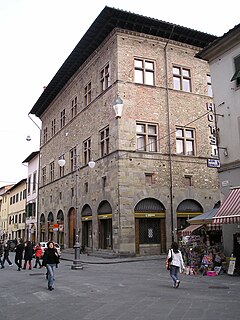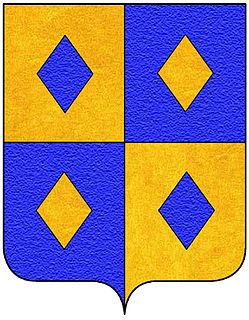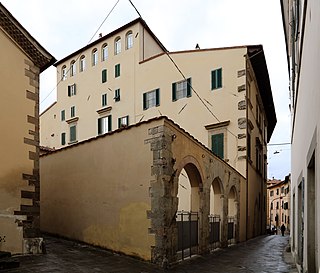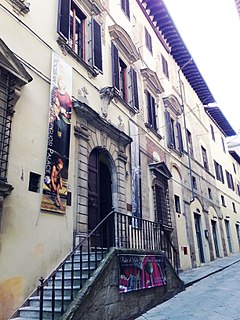
The Palazzo Ganucci Cancellieri is a late-Mannerist-style palace located at Via Curtatone e Montanara #51 in central Pistoia, Tuscany, Italy.

The Palazzo Ganucci Cancellieri is a late-Mannerist-style palace located at Via Curtatone e Montanara #51 in central Pistoia, Tuscany, Italy.
In 1609, the place at the site came into the possession of the prominent Cancellieri family; they refurbished it under the designs (circa 1615) of Jacopo Lafri. [1] In 1795, the palace was inherited by Giacinto Ganucci. A the coat of arms of the Cancellieri family (1598) sits awkwardly atop the doorway into the small balcony, the top entrance portal in the center of the facade; it was moved here from the family's former home (Palazzo delle Cancellieri Bianchi) on the west flank of Piazza Bartolomeo. [2] [3]

Palazzo Panciatichi or Palazzo del Balì is a medieval aristocratic palace located on Via Camillo Benso Cavour #35 in Pistoia, Tuscany, Italy. It a block away from the Palazzo Fioravanti.

Palazzo Tucci is an 18th-century palace in central Lucca, Region of Tuscany, Italy.
Francesco Girolamo Cancellieri was an Italian writer, librarian, and erudite bibliophile.

The Rospigliosi family is an ancient noble Italian family from Pistoia. Attested since the Middle Ages, it became wealthy through agriculture, trade and industry, reaching the apogee of its power and the high nobility status in Rome thanks to Giulio Rospigliosi, elected pope in 1667 with the name of Clement IX.

The Palazzo Lanfranchi-Toscanelli, presently the local State Archives, is a Renaissance-style palace located on Lungarno Mediceo #30, in the city of Pisa, region of Tuscany, Italy. Since 1913 the building has housed the Archivio di Stato di Pisa.
The Palazzo Lanfranchi is a palace located on Lungarno Galileo Galilei #8, in the city of Pisa, region of Tuscany, Italy.
Pasquale Saviotti (1792–1855) was an Italian painter and engraver who worked in a Neoclassical style.

The Fioravanti family were a noble family originating in Pistoia in Tuscany and active in Florence and other Italian towns. They were Guelf in their politics and naturally allied with the Cancellieri family and adversaries of the Ghibelline Panciatichi family. An early record dates to 1267, when Fioravanti d'Accorso was a member of the town council. In 1310 Ranieri, his son, was Mayor of the Pistoia. In 1319 Simone di Ranieri was a member of the elders. Giovanni di Puccio di Ranieri Fioravanti was a banker active at the court of Pope Clement V (1305-1314) in Avignon. Andrea di Simone di Baldo Fioravanti was elected Capitano della Montagna Superiore, June 17, 1354. Francesco di Rinieri was the Gonfaloniere of the Florentine Republic in the years 1385 and 1389: Neri his son was also Gonfaloniere in 1428; Fioravanti di Piero was the Cavalry Captain in Flanders in 1510 and then for Pope Alessandro VI, commissioner at Assedius of Faenza: Vincenzo di Cipriano one of the first to be elected knight of Santo Stefano, in 1576, shortly after the establishment of that military order, and later Chancellor of the Order: Fabio of Cipriano, was Cavalry Captain in the Netherlands: Alberto di Fioravanti Knight of Malta in 1590, and Commendatore in 1610: Niccolao di Fioravanti captain in the emperor Ferdinand II against the King of Sweden in 1636, and in 1643 in Tuscany for the Grand Duke against the Barberini.

The Palazzo Sozzifanti also known as the Palazzo Buontalenti is a Renaissance-style palace located at the intersection of Via del Carmine, Via de' Rossi, Via Abbi Pazienza and Via Sant'Andrea in central Pistoia, Tuscany, Italy. The palace is used in 2019 as a temporary exhibition site by the Cassa di Risparmio di Pistoia and Pescia Foundation.

The Palazzo Marchetti is a Baroque-style palace located at Via Curtatone e Montanara in central Pistoia, Tuscany, Italy. The palace, which once served as a civic art gallery, is used in 2019 as a civic archive for various family collections of documents.
The Palazzo Fioravanti, formerly Palazzo Gherardi-Peraccini is a 15th-century early-Renaissance style palace located at Via Benso Cavour #20 in central Pistoia, Tuscany, Italy. It stands across the street from the north flank of the church of San Giovanni Fuorcivitas.
The Palazzo Bracciolini is a Neoclassic-style palace located facing the Piazza del Duomo in central Pistoia, region of Tuscany, Italy. The palace, which once served as private home for the aristocratic family, has offices, retail cafe, and government offices.

The Palazzo Rospigliosi a Ripa del Sale or Rospigliosi sulla Ripa is a former aristocratic palace located at Via Ripa del Sale number 3 in central Pistoia, Tuscany, Italy. The location is in a small alley adjacent to the Pistoia Cathedral, within the most ancient set of city walls. In the 19th century, the palace was donated to the diocese and now is used as both Diocesan museum and for the display of the collection donated by Clemente Rospigliosi.

The Palazzo Rospigliosi a Via del Duca is a former aristocratic palace located at Via Ripa del Sale number 3 in central Pistoia, Tuscany, Italy. The palace was the birthplace in 1600 of Giulio Rospiglio, later Pope Clement IX.

The Palazzo degli Anziani also known as the Palazzo del Comune, della Comunitá or del Giano is a Gothic-style stone palace located in the ancient historic center of Pistoia, Tuscany, Italy. The palace served as city hall for centuries; it still belongs to the comune and now mainly houses the Museo Civico d'Arte Antica.
The Palazzo Rossi is a former aristocratic palace located at Via Rossi in central Pistoia, Tuscany, Italy. The palace now serves in part to house collections and offices of the Fondazione Cassa di Risparmio di Pistoia e Pescia.

San Leone, once called the oratory or church of Santo Spirito, is a small Baroque-style Roman Catholic church located adjacent to the Vivarelli Colonna in Pistoia, region of Tuscany, Italy. In 2017, restoration of the Baroque era frescoes in the apse and ceilings were completed.

The Famedio or Pantheon of Illustrious Men is a Neoclassic-style shrine or temple located at the end of a tree lined path, just off Piazza San Francesco #9, in Pistoia, region of Tuscany, Italy. The shrine was envisioned in 1812 as a secular memorial to famous men of Pistoia.
The Palazzo del Priorino is a Baroque-style palace on Via Pacini in central Pistoia, Tuscany, Italy.
Cancelieri is a surname of Itlaian origin. Notable people with this surname include: